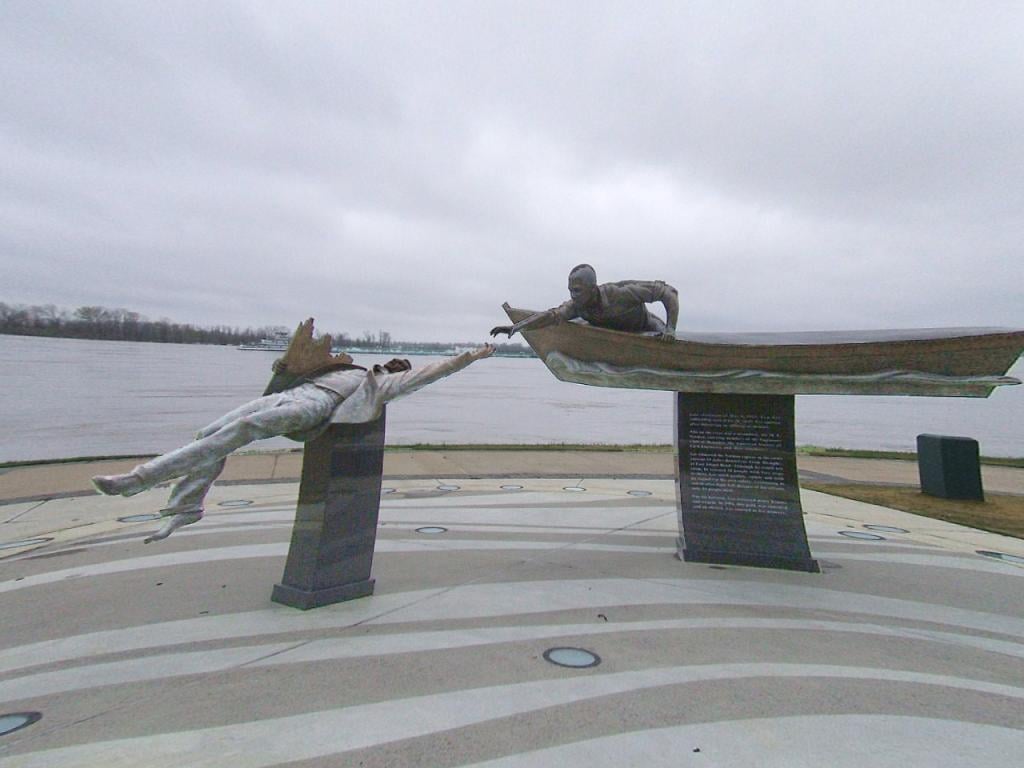
The Hand That Wasn’t There…
Just after Tyre Nichols died in Memphis in 2023, I took a look at photos that this aspiring photographer had posted to his website.
Nichols had taken lots of photos of bridges around Memphis, and it was eye-opening to see how this Memphian saw his community through the lens of his camera.
But one photo in particular struck me: a photo of the monument to Tom Lee, in the park named for him on the Mississippi River, in Downtown Memphis.
Truthfully, Tom Lee’s story should inspire us all. That a black man who couldn’t swim saved 32 persons who otherwise would likely have drowned on May 8, 1925, is a story for the ages.
He didn’t know how to swim…
Laborer Tom Lee had never learned to swim. He might have known a healthy fear of the power of rivers and oceans from stories passed down by his ancestors – rivers and oceans across which they’d traversed from another continent long before.
Nonetheless, according to an exhaustive history shared by Memphis Magazine, Lee had taken a job working for C.W. Hunter in Memphis – a company that performed levee repair work along the Mississippi River. Lee did whatever odd jobs were assigned to him. His job on May 8, 1925, was carrying his boss downriver to Helena, Arkansas, aboard his small motorboat, the Zev.
Traveling along the same route that day were two steamers, the Choctaw and the Norman. The Mid-South Chapter of the American Society of Civil Engineers was meeting in Memphis, and the Engineers Club of Memphis planned an outing to view a project south of the city. The visiting engineers and their families were to travel to the project site aboard the Choctaw and the Norman. 72 of the visitors traveled aboard the Norman, which had never carried such a large group of passengers.
Lee stopped on his way back to Memphis to work on his boat motor. He happened to see the Norman as it chugged along the Mississippi River.
Lee may not have been truly at home on the water, but he knew enough about those riverboats to realize something was wrong when he saw the Norman that morning on his way back to Memphis from Helena. He kept watching the vessel as he got underway again.
The Choctaw returned to Memphis without incident. The Norman capsized.
He didn’t hesitate…
An observant Tom Lee hurried to the scene, reaching out to pull the Normans’ passengers out of the water. Only able to carry about eight passengers at a time from the site of the Normans’ capsizing back to a sandbar, Lee later expressed amazement that the persons he was able to rescue remained calm as he pulled them out of the river’s cold waters that day. The calm of the rescued and the rescuer likely served them all well.
In his small wooden boat, Lee rescued 32 persons who had been aboard the Norman. Most of the other passengers drowned.
No one might have expected Lee to be able to rescue the Normans’ passengers. Some folks might have thought that Lee would have feared an attempt to rescue the victims. Engineers caught off guard by the events of the day couldn’t save the Norman, its crew or passengers. But Tom Lee persistently continued to look for survivors even after others had given up for the night.
Survivors whom Lee pulled from the cold water of the Mississippi River quickly credited him for having saved their lives. Accolades began pouring in from around the country as the story was told. Lee received a gold watch and much publicity. He even met President Calvin Coolidge, who wanted to convey his own appreciation to Lee for his heroic efforts.
In 1925, after all of the accolades, Lee was still a black man – and an unskilled laborer – in Memphis, Tennessee.
When someone asked Lee what he needed, he responded that he needed a house. The Engineers Club of Memphis began raising funds for a house for Lee. Money came in from many sources, and enough money was raised to purchase a house at 923 North Mansfield – a house which still stands to this day – and Lee and his wife had a home of their own.
Tom Lee, the laborer, the man who couldn’t swim, ended up with a job that kept him on dry land, working as a sanitation worker. Tom Lee worked in 1925 for 20 cents an hour as a sanitation worker, more than forty years before a black man named Martin Luther King, Jr. would come to Memphis to advocate for fair wages and working conditions for striking sanitation workers – advocacy that led to his assassination.
That brings us to a monument erected in 2006 to honor a man who faced the dangers of the Mississippi River with bravery and seeing the face of humanity around him.
Tyre Nichols was drawn to that monument. It was a Memphis image that Tyre Nichols chose to capture: With the Mississippi River as a backdrop, the monument captures Lee reaching for the hand of a man holding on to a broken piece of wood, struggling to stay afloat in the river. He photographed it, and added that photo to his website – along with many photos of bridges that he had taken.
Where was the hand…?
Bridges span a distance that is otherwise unreachable. On January 7, 2023, the distance between Tyre Nichols and help was unnavigable. There was no Tom Lee to reach a hand to Tyre Nichols to pull him from the hands of police officers who beat him. Instead, Tyre Nichols lay on the ground as those sworn to protect and defend a community and its citizens beat, punched and kicked him. Three days later, he succumbed to his injuries.
One hundred years after Tom Lee’s heroic acts, perhaps it’s time to recall again the story of a laborer in Memphis who didn’t look the other way, didn’t mind his own business, didn’t head back to Memphis when he saw a steamer in trouble, didn’t hesitate, didn’t allow fear to stop him and realized even in his small boat, not knowing how to swim, his hands were better than none.
Tom Lee’s story is the story of Memphis in so many ways – a Memphis that finds its heartbeat in the life-giving and simultaneously threatening waters of the Mississippi River. It is, and has been, a city in which the lifelong dweller and the transplant, the impoverished and the elite, the well-heeled professional and the laborer, the die-hard believer in this place and the most ardent critic, all find home. Memphis is a home in which many of us have grown to love all that the city is and has the potential to be.
Forever linked in history…
A young man who photographed a monument to a 1925 Memphis hero, that hero’s later work as a sanitation worker, and a Southern Civil Rights leader who years later would be martyred in Memphis as those workers’ advocate are now linked in history. One of those men needed a neighbor on a cold January night in 2023 in Memphis. Two of those men have shown us what being a neighbor means, in that scriptural way of being neighbor: looking after all who need our support, never giving up on God’s people, and showing mercy. As Jesus would tell an inquiring lawyer, “go and do likewise.”












